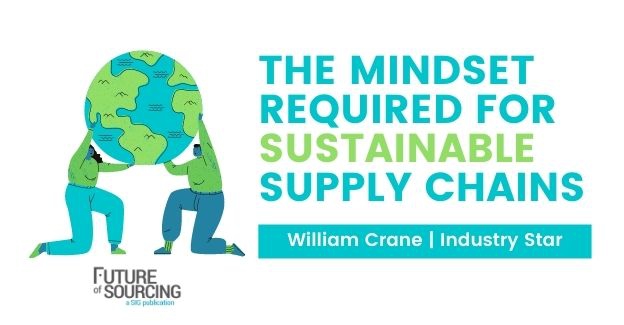Even if your company doesn’t pay for waste immediately, says IndustryStar CEO William Crane, a lack of sustainable processes, parts and products within the value chain should be acknowledged as a supply risk.
Supply chain and sustainability are two sides of the same coin. A standard teaching practice within supply chain is “lean thinking” that advocates for minimalist, one-piece flow to the tune of an ever-present waste reduction drumbeat. Unfortunately, this drumbeat isn’t always heard. The prevalence of waste in far-reaching corners of supply chains is in large part due to the sheer global scale of many manufacturers.
Simply put, the end-to-end automotive value chain size and complexity can create more siloed than required systems thinking. After all, it is the sum of all processes from handling to assembling at all stakeholders from OEMs to suppliers that determine how efficient, or inefficient, value is delivered.
Exacerbating matters further are elongated automotive supply chains that expanded with wide-scale global sourcing in the early 1990s. Our push for lower-cost parts was accelerated by synergistic desires to outsource unsavory processes to achieve ISO 14001 environmental management system certification in North America and Europe starting in 1996.
The net result is that we greened our facilities at home but passed the waste buck to factories abroad in China and elsewhere. Perpetuating this linear thinking solely on small internal continuous improvements stands to curtail teams’ innovation potential. This approach is more troubling for manufacturers today, as breakthrough thinking will be required to realize new opportunities as the industry rapidly shifts toward sustainable mobility technologies and models.
As professor Stuart L. Hart pointed out in 2008 in his trailblazing book Capitalism At The Crossroads, “In the long run, the dynamics of creative destruction will work against firms that rely only on incremental improvements and fail to change the fundamental manner in which they provide products, processes and services.”
For many, the contemplation of reshaping the future has been interrupted by the present barrage of crises from raw material supply shortages to pricing volatility. The longer workweeks have reinforced the value of fostering more resilient business models. More than ever, we need to care not just about what the cost is of the parts that go into our products but how those parts are made and where they end up. We need to delve deeper than the historical industry best practice of total cost of ownership, which strives in theory to quantify risk and disposal costs. Did these models properly account for the prolonged pandemic? Case rested.
Looking ahead, we must go beyond attempting to compartmentalize our organizations’ cost. Our true product costs are much broader and deeper. Luckily the analysis, at least conceptually, is equally as straight forward, but it involves a fundamentally different way to approach supply chain work.
We must transition from cost czar to value enabler. It requires that we strive to eliminate waste in its expanded form of non-sustainable waste. If a purchased good is not sustainable, then waste, or money for that matter, is left on the table. Thus, by definition, supply chain’s cost optimization historical pursuits are aligned with fostering sustainable business models.
Building a Bias Toward Action
The sad truth is that often our words do not always align with our supply chain actions. There is still too much incremental improvement. An all-new electric truck, while better for the environment than its internal combustion engine predecessor, is still packed full of virgin plastic resin destined for landfills. Bringing sustainable parts and assemblies to market requires disruptive thinking to kickstart all-new ways of working. It requires widening our supply chain lens to include not just immediate suppliers, but all stakeholders up and down the value chain.
Detroit-based innovative startup Pivot Materials blends agricultural waste materials such as bamboo fibers, rice hulls and even coffee hulls into resin feed stock to enable more sustainable plastic injection molded parts. Replacing even a portion of virgin resin with lightweight sustainable material alternatives can reduce part weight from 7% to 20% on average in parts ranging from A pillars to ducting.
“Just recycling isn’t enough anymore. Our focus is on upcycling, which takes waste materials such as leftovers from farming and gives them a new life. Depending on the application, we are able to replace 10% to 100% of traditional plastics in automotive parts and shipping pallets,” says Pivot Materials co-founder and CEO, Kylee Guenther.
Putting the moral point of view aside, it is supply chain’s job to ensure the most efficient flow of value possible. Even if your company doesn’t pay for waste immediately, a lack of sustainable processes, parts and products within the value chain should be acknowledged as a supply risk. Fortunately, today’s sustainability price is becoming more quantifiable. Electric startup vehicle manufacturer Rivian’s IPO on November 10, 2021, resulted in a $91 billion market cap which surpassed General Motors’ $86.4 billion market cap.
The track records, revenue forecasts, and operational scale differential between the OEMs is substantial. However, the stock market, as a barometer for future cash flows, is clearly stating that a pure play sustainable automaker is more valuable than a legacy OEM on a journey to becoming more sustainable.
As a counter narrative, a lesser discussed aspect is General Motors’ 2020 Sustainability Pledge, which outlines the company’s requirement that 35% of vehicle parts will be made from sustainable materials by 2035. This positive step forward highlights the immense sustainability impact established OEMs and suppliers can have now through spend influence.
According to the American Chemistry Council, “Today's vehicles on average contain 50% plastics by volume and 10% by weight.” At over 300 pounds of plastic per vehicle and 6.8 million vehicles sold in 2020, General Motors and their suppliers stand to replace north of 2 billion pounds of plastic resin annually with sustainable material alternatives.
Where to Start
The harsh reality is that much of the input data that goes into assemblies isn’t known by buyers. This goes beyond simply knowing Tier I suppliers toward building an expanded digital Plan For Every Part. An example is documenting your Tier II and III supplier’s inbound packaging and logistics carriers, which have remained largely invisible.
This may seem absurd; most know raw materials, purchased parts and piece prices in depth. However, do you know the total weight of your spend that ends up in a landfill? As we have seen, few automotive Tier I suppliers track this level of data about their Tier II suppliers. Reasons vary, but in short it can be a lot of work. Put another way, the answers to the questions might also be unsettling.
There are parallels between the continuous improvement and creative destruction mindsets in that both are required paths toward elevating supply performance. It is important to acknowledge supply chain sustainability continuous improvement results as small wins along the journey to build momentum.
Making Meaningful Impact
We must not celebrate incremental improvement too prematurely as to award ourselves green trophies for a job completed. Measuring our impact in the context of what we could realize offers a clearer lens from which to pursue future impactful results.
To accomplish this, sustainability must move from reactive to proactive thinking to maximize impact. True sustainable supply chains must be pursued from day one in partnership with all stakeholders. “Cradle to Cradle” thinking, as outlined by architect William McDonough and chemist Michael Braungart in their 2002 book Cradle to Cradle: Remaking the Way We Make Things, needs to start at new product creation and be realized during sourcing to maximize impact. Thus, the mindset is more principle than method.
Results take upfront and persistent engagement inside and outside the organization. This is a different way to manage and execute supply chain work for most professionals. It is through bold thinking and purposeful actions that profitable sustainable business models, and the supply chains that power them, can take hold to enabler a better future for all.









